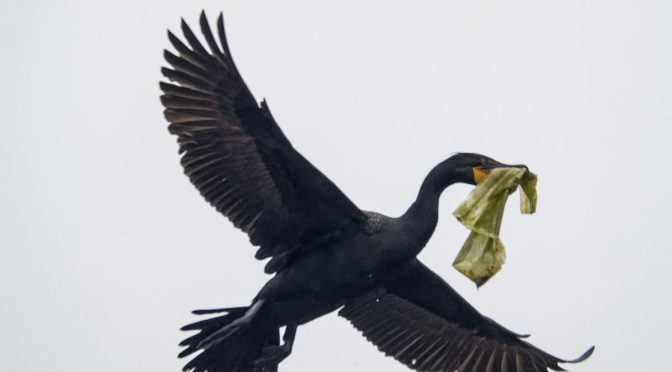There are times when using 60 frames per second can make a lot of sense, even though a photographer may have to give up continuous auto focus with this fast frame rate. This article shares a selection of 10 consecutive images captured at 60 frames per second to illustrate the potential trade-off benefit.
Before we get into this article I should explain why I specifically chose to show images of a black bird (cormorant) captured against a dull, gray overcast sky. Obviously this combination of subject matter and lighting does not yield great photographs.
The contrast and lack of background does help to accentuate subtle differences in subject movement, which is one of the main points of this article. So, I apologize in advance for the overall quality of the photographs.
All of the iamges in this article are shown as 100% captures without any cropping done to them.
NOTE: Click on images to enlarge.

One of the things that photographers sometimes overlook with their cameras are the fast frame rates that are often available with mirrorless equipment.

By fast, I mean frame rates like 60 frames per second at full image resolution. This type of frame rate gives us the ability to capture a series of photographs with small, incremental subject movements.

Often when we first experiment using 60 frames per second we do so in two specific bird-in-flight situations. A bird taking flight, or a bird landing at a nest.

We do this since our cameras typically lock focus and exposure based on the first frame, and we fear that not having continuous auto-focus when using 60 frames per second will result in out of focus images.

Our typical rationale is that we can limit the risk of out-of-focus images since our subject bird will not be physically moving very far when taking off or landing, and therefore it should stay in focus.

It is interesting to note that the 10 photographs in this article were captured in a total of 1/6 of a second using a Nikon 1 V2. That’s a lot of frames in very little time. This also means that even a bird-in-flight like the cormorant in these photographs, doesn’t travel a great distance during that restricted time frame of 1/6 of a second.

As long as we are careful with subject size and direction of flight, there is no reason why we have to restrict our bird-in-flight photographs to continuous auto-focus and slower frame rates. As many of us have experienced, using slower AF-C frame rates like 10 FPS can yield somewhat boring and repetitive wing positions, with very little variation in our bird-in-flight photographs.

Using 60 frames per second can be a great choice, especially when photographing larger birds that are flying parellel to the focal plane of our camera. Capturing very rapid ‘pulse bursts’ of images at 60 frames per second can generate a wonderful array of wing positions in our images, while limiting the risk of out of focus photographs.

As you can see from the 10 photographs featured in this article, using 60 frames per second can capture many subtle differences in wing and body position.

Using this technique may enable you to capture some very interesting wing positions, even when subject birds are in full flight.
Regardless of the brand of camera gear that you may own, using its fast frame rate capabilities with birds in full flight may be something worth investigating. Being able to shoot at 60 frames per second is something that I’ve always loved with my Nikon 1 kit, and also my Olympus camera gear.
If you enjoyed the images in this article you may want to check out our Nikon 1 eBook: The Little Camera That Could. It is available for purchase and download. It is priced at $9.99 Canadian. Readers interested in purchasing a copy can use the link below.
Technical Note:
Photographs were captured hand-held using camera gear as noted in the EXIF data. Image were produced from RAW files using my standard process. Photographs are shown as 100% captures without any cropping done to them.
How you can help keep this site advertising free
My intent is to keep this photography blog advertising free. If you enjoyed this article and/or my website and would like to support my work, you can purchase an eBook, or make a modest $10 donation through PayPal. Both are most appreciated. You can use the Donate button below. Larger donations can be made to tom@tomstirr.com through PayPal.
Word of mouth is the best form of endorsement. If you like our website please let your friends and associates know about our work. Linking to this site or to specific articles is allowed with proper acknowledgement. Reproducing articles, or any of the images contained in them, on another website or in any social media posting is a Copyright infringement.
Article is Copyright 2020 Thomas Stirr. Images are Copyright 2016 Thomas Stirr. All rights reserved. No use, duplication or adaptation of any kind is allowed without written consent. If you see this article reproduced anywhere else it is an unauthorized and illegal use. Posting comments on offending websites and calling out individuals who steal intellectual property is always appreciated!


